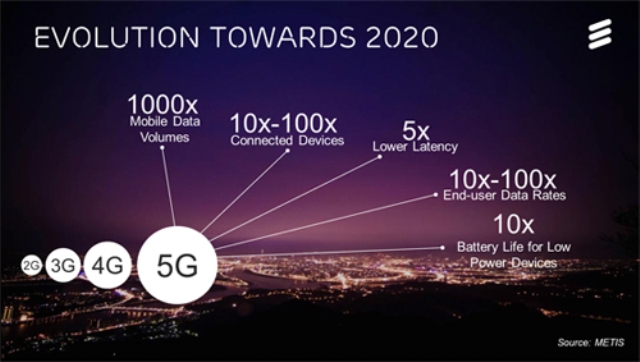
At the Mobile World Congress (MWC 2016) in Barcelona, Ericsson is gearing up several 5G related announcements involving KT and NTT DOCOMO.
Indications are the commercialization of 5G services will be happening in 2020.
The technology company says Ericsson 5G Radio Prototypes use Multi-user, Multiple Input, Multiple Output (MU-MIMO) and Massive MIMO to increase downlink throughput. They use advanced beam-tracking, which is required in millimeter wave bands to ensure high performance and reliability for users as they move through the network.
Ericsson and NTT DOCOMO are already conducting joint outdoor trials to understand how 5G will really perform in the field.
Seizo Onoe, chief technology officer at NTT DOCOMO, said: “This will enable us to plan for the new and enhanced services that we will be able to offer with 5G. We will be in a position to highlight our commercial 5G capabilities in 2020.”
Korean telecom network operator KT is aiming to preview the new 5G services at the PyeongChang 2018 Olympics.
Dongmyun Lee, chief technology officer at KT, said: “Ericsson is enabling us to trial 5G capabilities with the advanced features, like beam tracking, MU-MIMO and Massive MIMO, that we will need as we plan for 5G commercialization.”
Ericsson said its 5G Radio Prototypes are currently delivering more than 12 Gbps mobile experience per user, in live networking environments with downlink throughput of more than 25 Gbps using MU-MIMO.
The live demonstration for both NTT DOCOMO and KT took place indoors on the Ericsson campus in Kista, Sweden and will also be featured at the upcoming Mobile World Congress in Barcelona. Each compact 5G Radio Prototype – the size of a piece of carry-on luggage – supports the equivalent of 40 LTE carriers.
Arun Bansal, head of Business Unit Radio, Ericsson, said: “With Ericsson’s 5G Radio Prototypes, we are supporting MU-MIMO, Massive MIMO and beam-tracking to make the greater bandwidth available in millimeter wave spectrum commercially viable.”
The multi-Gbps speeds delivered by Ericsson 5G Radio Prototypes can support mobile broadband and video demand on smartphones and other mobile devices. They provide cost effective alternative to residential fiber connections.
Ericsson said 5G will impact the Internet of Things (IoT), enabling new applications for smart vehicles and transport architecture, remote control of heavy machinery in hazardous environments, remote surgery and new levels of human-IoT interaction including immersive augmented reality and immersive gaming.
Ericsson cloud servers
Meanwhile, Ericsson and NTT have initiated a collaboration focusing on the next generation of cloud servers.
Ericsson and NTT will conduct a study for determining how hardware disaggregation, management and control technologies can improve the efficiency of operations and application software development. The target is to realize benefits such as increased hardware utilization, efficiency and simplification in operation and application software development.
The collaboration will verify capabilities and functionalities of Ericsson’s Hyperscale Datacenter System 8000 based on Intel Rack Scale Architecture. The Ericsson Cloud Manager and Ericsson Cloud Execution Environment solutions will also be deployed.
Baburajan K
[email protected]





